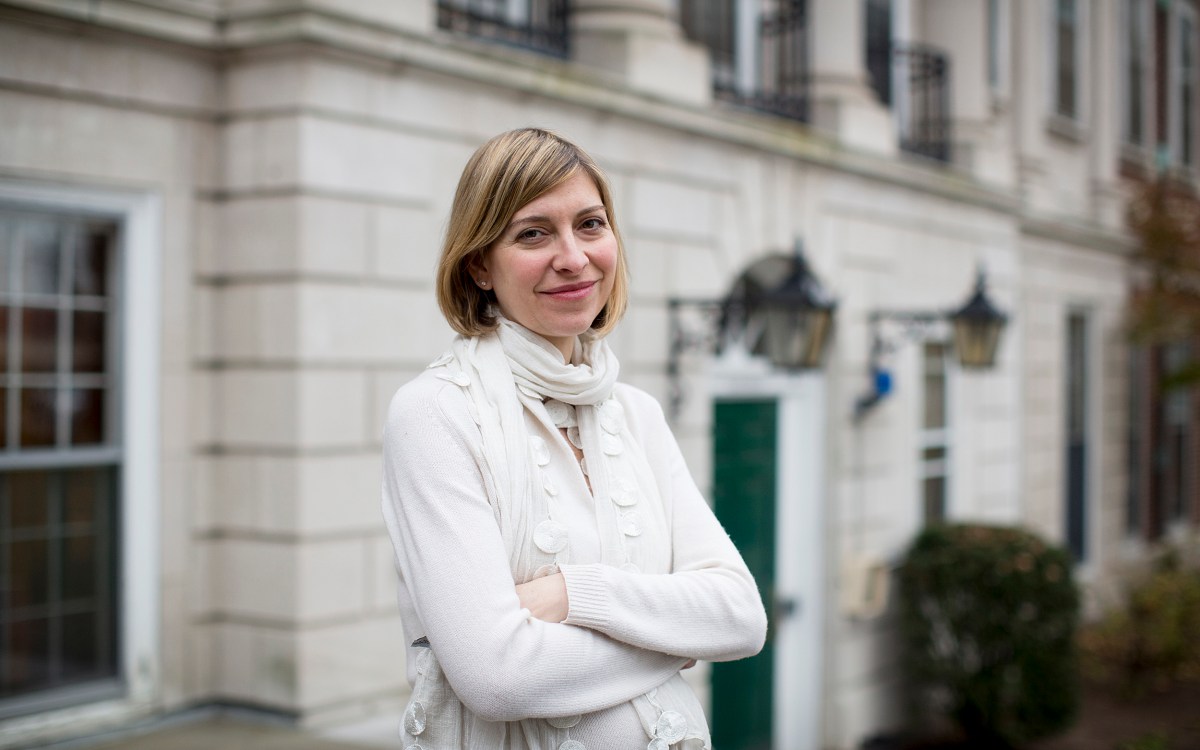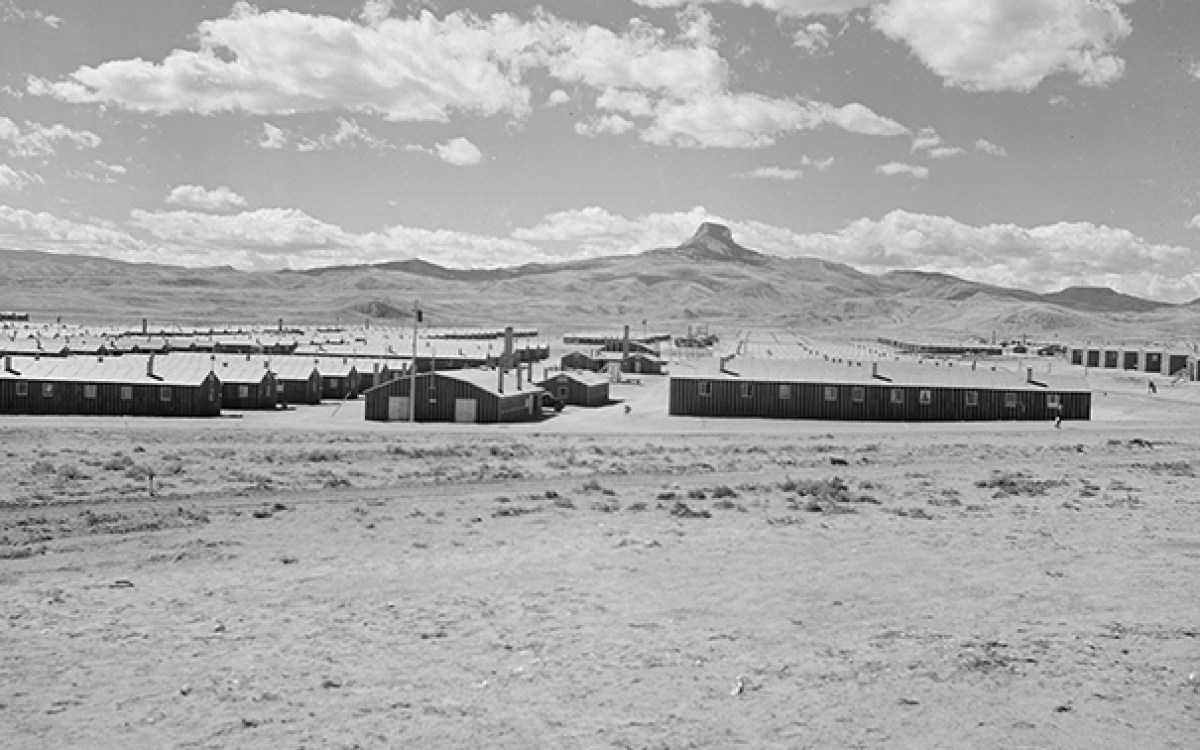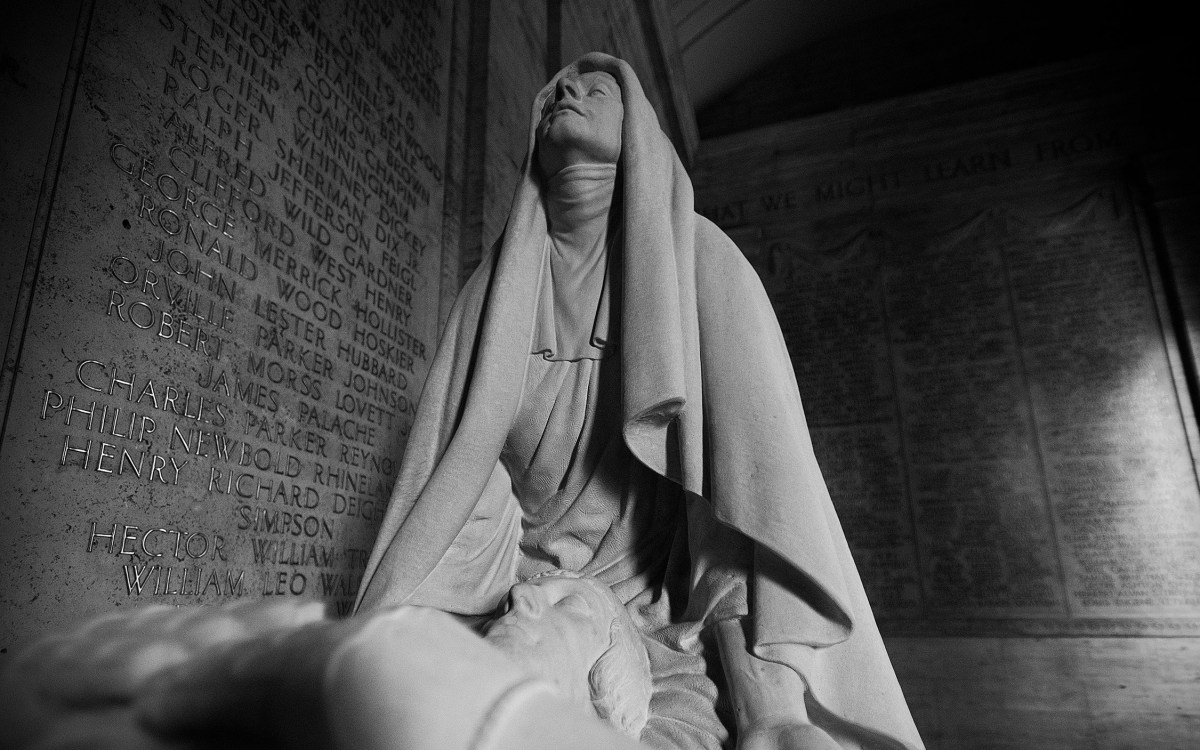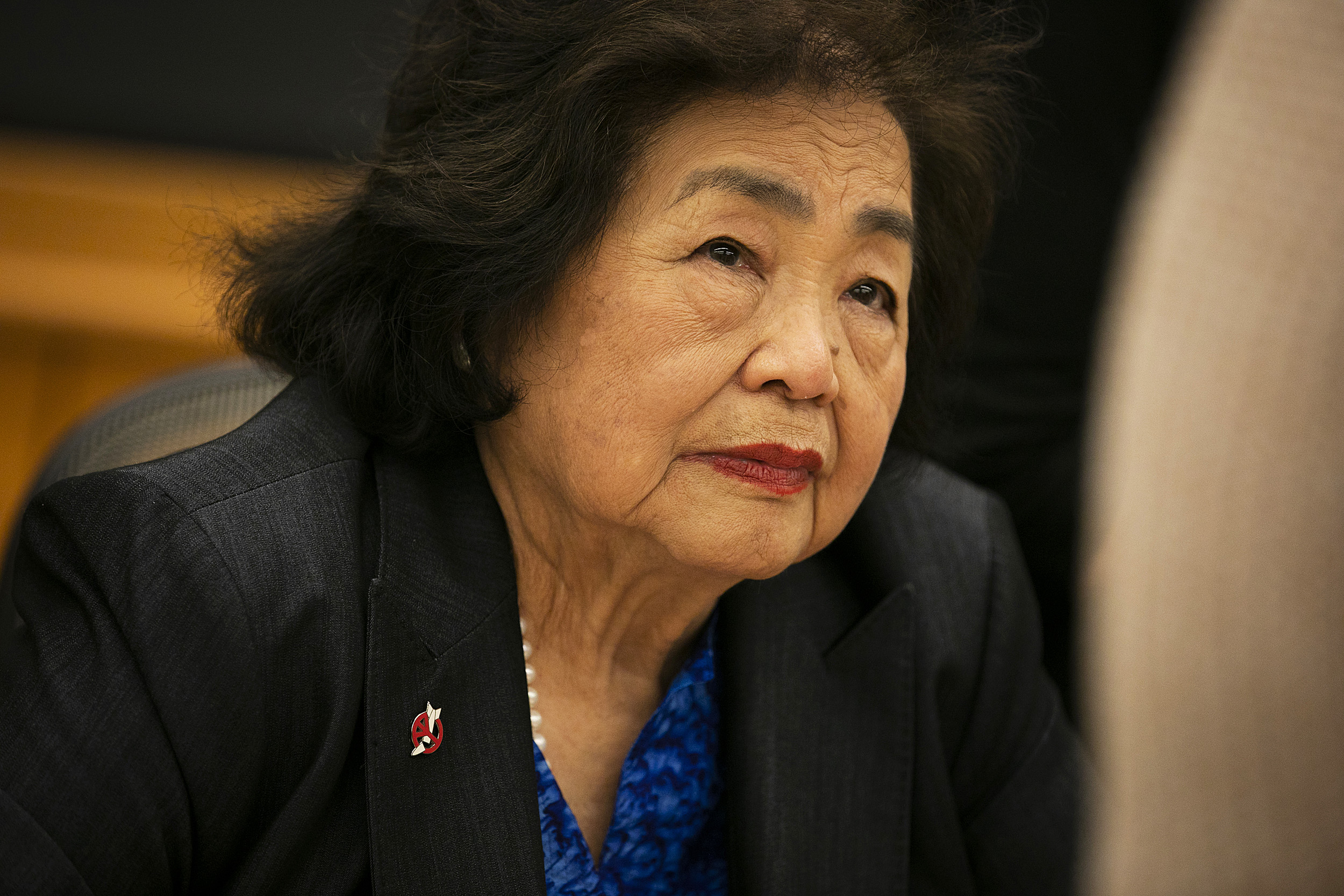
Setsuko Thurlow, a survivor of the Hiroshima nuclear bombing, shares her story at Harvard Law School.
Photos by Stephanie Mitchell/Harvard Staff Photographer
A living witness to nuclear dystopia
Hiroshima survivor recalls the bombing, the devastation that followed, and her life as a disarmament advocate
First came a flash. Thirteen-year-old Setsuko Nakamura felt as if she were drifting skyward. And then darkness.
Seventy-four years later Setsuko still remembers the moment of detonation after the U.S. dropped the atomic bomb on Hiroshima, the first of two exploded over the island nation, a deployment that proved so horrendous the weapons have never been used since.
“That very morning I was at the military headquarters, not at the school,” she told a rapt audience at Harvard Law School on Tuesday as part of the University’s Worldwide Week. Instead of being in class on Aug. 6, 1945, Setsuko was reporting for her first day of work, as one of the thousands of students the government mobilized to provide cheap labor during the wartime shortage.
Setsuko, who now uses her married last name Thurlow, and about 30 other girls were assigned to help the army decode top-secret messages. They were about a mile from ground zero and on the building’s second floor.
“Sharp at 8 o’clock the assembly started,” she said. “Maj. Yanai was giving a pep talk: ‘This is the day you prove your patriotism to the emperor. Do your best,’ and so on. We said, ‘Yes, sir! We’ll do our best.’ Then at that second I saw the blinding blueish-white flash in the window, and I had a sensation of floating up in the air.” Then she lost consciousness.
As a living witness to the devastation and human suffering the use of nuclear weapons brings, Thurlow has been telling this story for decades now. Often she brings her listeners to tears, as she did this day.
“I speak because I feel it is my responsibility as someone who has intimate knowledge of what these horrific things can do to human beings,” Thurlow said. “I consider it my moral responsibility.”
The 87-year-old is best known for her advocacy work with the International Campaign to Abolish Nuclear Weapons, a global coalition working to make the arms illegal. As a leading figure and spokeswoman for ICAN, Thurlow was on hand to accept the Nobel Peace Prize with the group in 2017 when it was recognized for its role in the United Nations’ adoption of the Treaty on the Prohibition of Nuclear Weapons, which would completely ban all nuclear arms if implemented.
To date, 32 countries have ratified the accord; 50 are needed for it to become law. None of the nine nuclear-armed nations, including the U.S., have signed on, and in fact, they actively oppose it, viewing the weapons as a way to maintain peace and assure security under the threat of mutually assured destruction.
“A Survivor’s Story: From the Atomic Bomb to the Nobel Peace Prize” was organized by the Armed Conflict and Civilian Protection Initiative and co-sponsored by the Human Rights Program, HLS Advocates for Human Rights, and Hibakusha Stories/Youth Arts New York. The event came at a time of heightened tensions among nuclear powers and followed years in which Iran and North Korea have aggressively pushed to develop their own weapons.
“The eyewitness accounts of Setsuko and other survivors provide a vivid reminder of the human consequences of nuclear weapons,” said Bonnie Docherty, associate director of Armed Conflict and Civilian Protection and lecturer on law at the Law School’s International Human Rights Clinic. During negotiations for the U.N. treaty, the clinic provided legal advice and advocacy support to ICAN.
The bombs dropped on Hiroshima and three days later on Nagasaki killed more than 200,000 people and practically destroyed both cities. In Hiroshima, the devastation was near-total, wiping out about 90 percent of the city while instantly killing more than 80,000 people.
“I speak because I feel it is my responsibility as someone who has intimate knowledge of what these horrific things can do to human beings. I consider it my moral responsibility.”
Setsuko Thurlow
Thurlow recalled the aftermath in harrowing detail. After regaining consciousness, “I found myself pinned under the collapsed building in total silence, total darkness,” she said. “I tried to move my body, but I couldn’t, so I knew I was faced with death … Then I started hearing faint voices of my classmates: ‘Mother, help me.’ ‘God, help me.’ ” She knew she was not alone. “Then all of a sudden someone started shaking my left shoulder from behind — a strong male voice: ‘Don’t give up! Don’t give up! Keep moving! Keep kicking! Keep pushing!’” He told her to crawl toward the light.
Once out, she found a hellscape. Smoke and dust filled the air. Buildings crushed into piles of debris. Fires everywhere, including in the rubble she’d escaped. A procession of severely burned and disfigured people slowly emerged, “shuffling from the center of the city to the outskirts.” She and three girls who’d also escaped the collapsed headquarters walked with them. “We learned how to step over the dead bodies,” she said.
They came to an army training ground the size of two football fields “packed with dead bodies and dying people.” She stayed there the rest of the day, bringing people water from a nearby stream. “When the darkness fell we sat on the hill and all night we watched the entire city burn, feeling numbed from massive death and human suffering we had witnessed all day,” she recalled.
Her mother and father were spared, but Thurlow lost eight members of her family as result of the bombing, including her 4-year-old nephew who died four days after the explosion.”
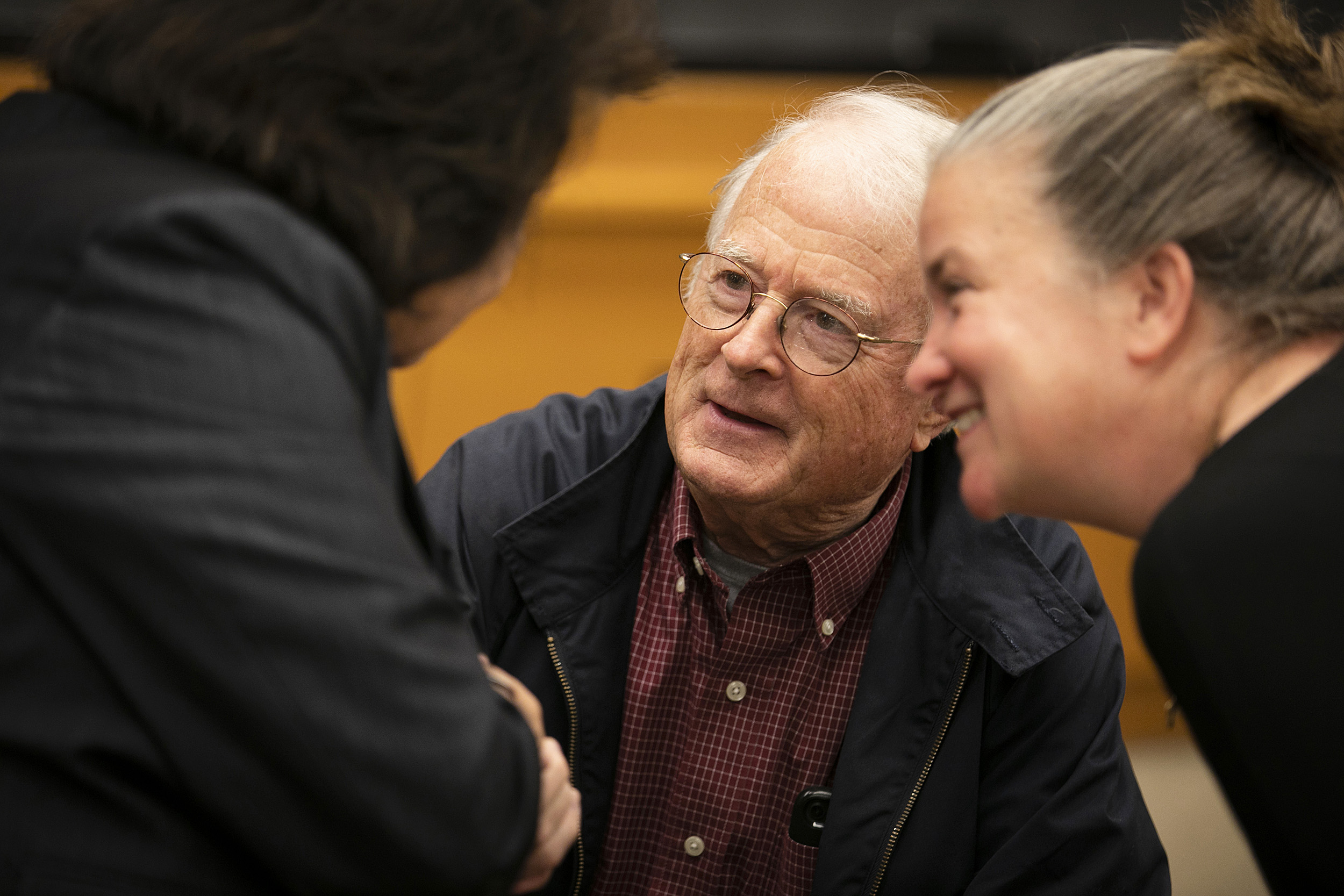
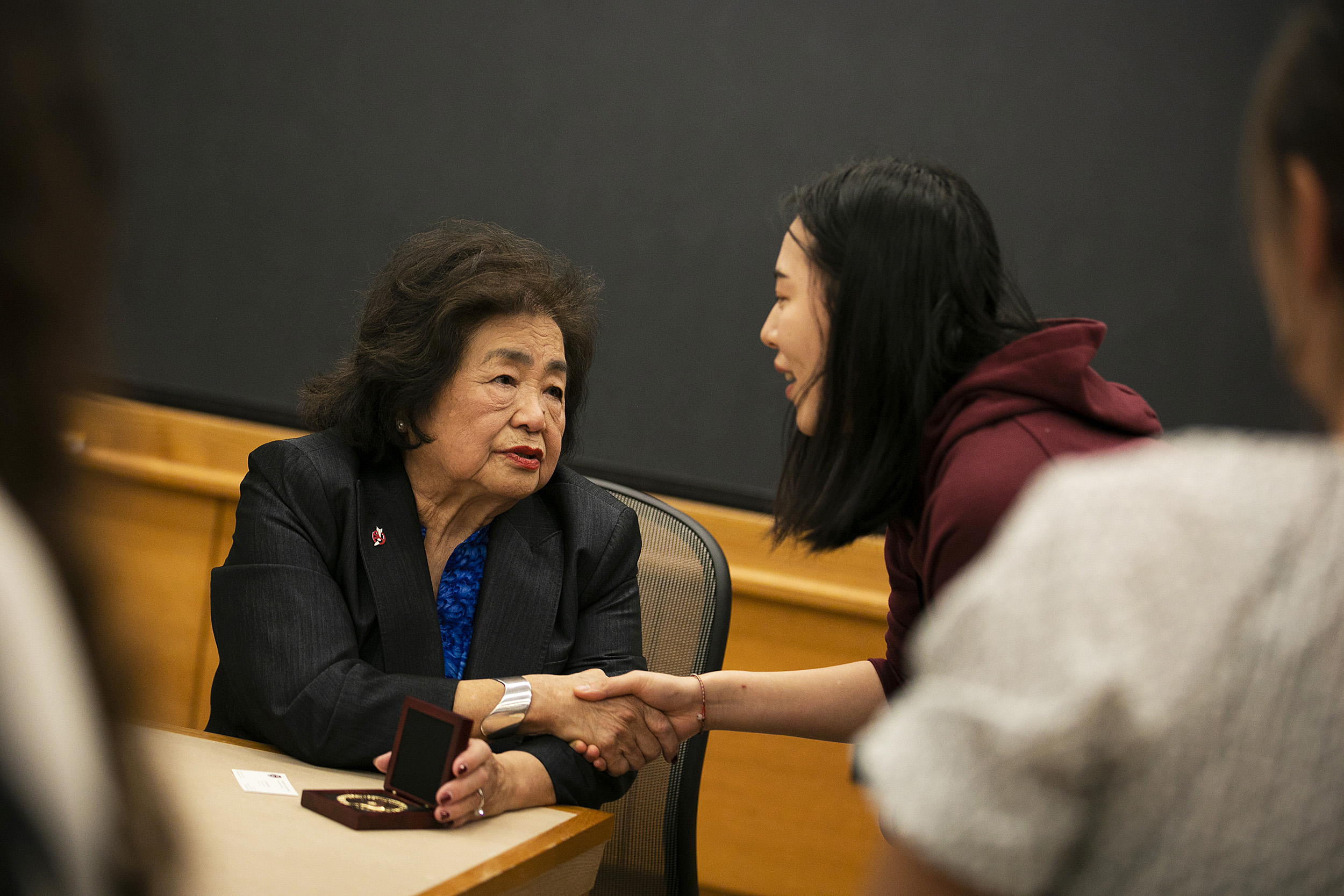
Setsuko Thurlow (from left) speaks with Loring Conant ’61, who went to Hiroshima as part of the Harvard Glee Club’s trip in 1961, and Kathleen Sullivan. Graduate School of Education student Yaoguang Cao meets Thurlow.
That was only the beginning. Days, weeks, and years followed with a steady stream of deaths from injuries and illnesses from the radiation; thousands coping with homelessness; American occupation; rebuilding and memorialization efforts; and the discrimination that survivors often from fears of the long-term effects of radiation exposure.
Thurlow said these experiences formed the basis of her anti-nuclear advocacy, which began in 1954 when she spoke out during an interview about her thoughts on the news of tests of an even more powerful bomb by the U.S. in the Marshall Islands. Since then, she has testified widely, including before world leaders such as Pope Francis and hundreds of diplomats during ICAN’s campaign for the Treaty on the Prohibition of Nuclear Weapons.
Thurlow said she was thrilled that the U.N. adopted the treaty, but admitted that it will be an uphill battle to totally eliminate nuclear weapons. And she called on listeners, especially students, to take up the cause.
“You are getting the best education,” Thurlow said. “You have a lot to return to your society, to humanity — not just to the United States, to the entire world. I am really asking you to take this issue seriously. It’s really a matter of life and death.”
The message struck a chord with many listeners, including law student Ragad Alfaraidy, who was among many who lingered after the lecture to meet Thurlow and see the Nobel medal, which she had on hand. Events like this, Alfaraidy said, inspire fresh thoughts for students wrestling with decisions about how to do something meaningful with their educations.
“We’re always torn between going to the private sector or going to the public sector,” she said, “and I believe talks like this draw important emphasis on things that we tend to forget sometimes.”



